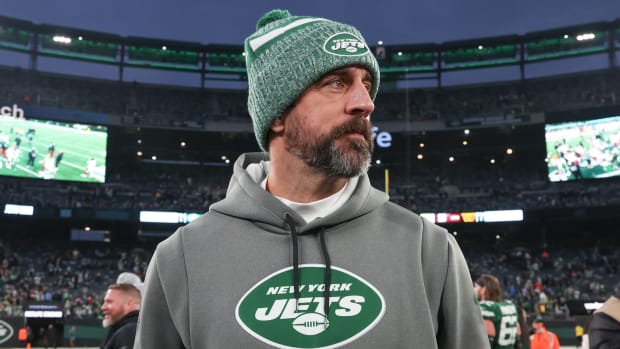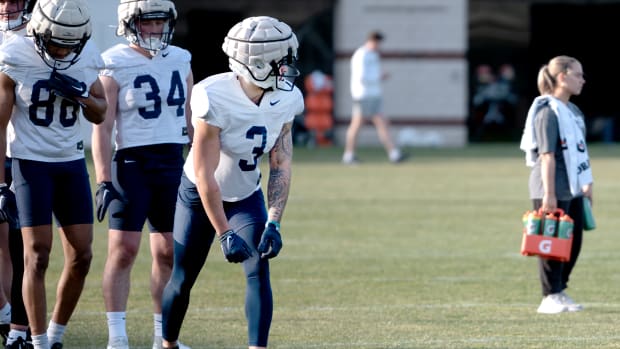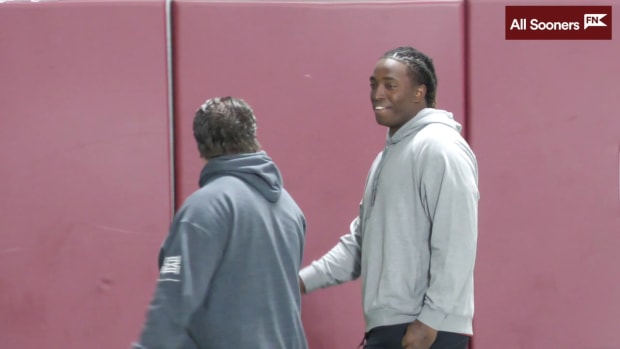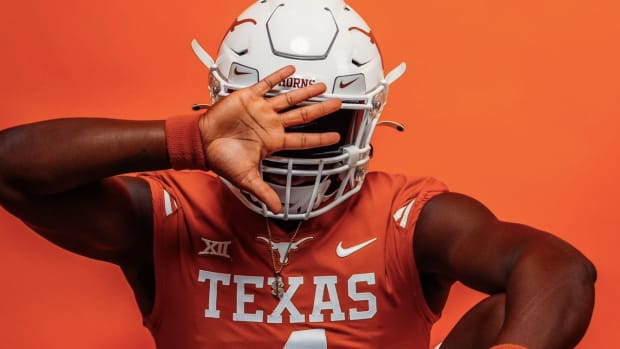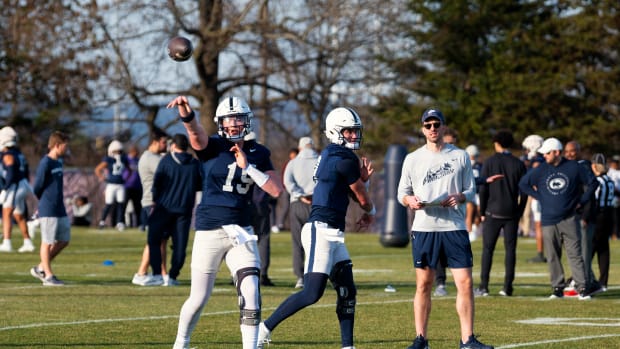After a Contentious Summer, Football Plays On. Why? It's Complicated.
The Isidore Newman School football team had its first practice in helmets on Monday. It had been a long wait. The season’s timetable was thrown off, like everything else in life, by the coronavirus.
Cooper Manning was driving by the prep school in Uptown New Orleans the day of that first practice. His two sons were on the field at the athletic complex, which bears the family name. What he saw as he rolled by made him laugh, a timeless and endearing family portrait of sorts.
“My dad has his car wedged up against the fence, watching practice from 100 yards away,” Cooper says. “He’s 71 years old, and he’s like an eight-year-old trying to watch through a hole in the fence.”
That would be Archie Manning. He was there spying on two of his grandsons, Arch (a quarterback of rising renown) and Heid (a freshman center). As the pater familias of America’s greatest gridiron clan, Archie has played more football and seen more football than just about anyone alive. He played in the NFL for 13 seasons, then watched sons Peyton and Eli win two Super Bowls apiece. Yet he still hungers for that next season.
“I just decided I’d ride by Newman,” Archie says, heeding the game’s eternal beckoning. “It’s just pure. We spent so many years going to NFL games, and before that college games. We went to Arch’s games last year, and it was wonderful to be back out and be part of everything that goes into a Friday night. The spirit of the kids, the band, the cheerleaders, homecoming.”
At the granular level, this is why football matters, and why people persist in playing it even now, amid a pandemic that has shut down so many other facets of life. It is ingrained in the annual rhythms of millions of Americans, a family anchor, a community touchstone. It shouldn’t matter this much—but for many, it does.
“So many people come up to me and say, ‘We’ve got to have football,’” Archie says. “I’m not putting football in front of health and safety, but I think it would help a lot of people if we can get through this and play.”
The first FBS college games will be played Thursday night: Central Arkansas at UAB and South Alabama at Southern Miss. A stripped-down schedule will follow over Labor Day weekend. The normal season-opening gluttony has been reduced to a couple of bland appetizers—but there will be food on the table for a football-starved populace.
For the famous athletes and the everyday fans alike, the sweet pungency of freshly mowed grass and the first crispness in the air means it’s time. Time to inject a sports drug that provides a rush like no other. But like any drug, it can have ruinous side effects.
Combatants may spend later years walking with a limp or living in a fog. Fans who take it too seriously can lose their minds as well. Now we have a new risk associated with football—spreading a highly infectious disease that has killed about 185,000 Americans and led to heart inflammation in several young players.
Any worries about your boys playing a sport the NCAA labeled “high-risk” for COVID-19 infection during a pandemic, Cooper Manning?
“Not a lick,” he says with a derisive chuckle. “The fact that it’s been missing in some places is interesting. It blows my mind that our puny-ass school is playing and some of the biggest college programs in America aren’t. Maybe it’s too important sometimes. But I like the fact that it’s a priority.”
***
At the opposite end of granular sits the Big Ten, a boulder of pressure weighing upon the oldest and richest college athletic conference. It is now a tortured entity, being hammered from all sides for daring to take what looked like a logical and prudent step. Whatever purity can be found on the high school field on Friday nights is not in evidence here.
On Aug. 11, the league announced that it would not play a fall football season. The resulting blowback has been amazing and at times alarming, perspective trampled beneath runaway emotions, leading to vicious conference infighting. The Big Ten was far from alone in its decision, joined by three other FBS conferences and 28 of the 34 conferences at the NCAA Division I level. But an 11–3 vote of league presidents that was built upon advice from medical experts has somehow become the latest political flashpoint in a summer full of them.
How much does football matter? Enough to potentially decide the 2020 presidential election? Certainly, enough for President Donald Trump to make a phone call Tuesday to the commissioner of the conference, Kevin Warren. Trump offered help with testing if it will get the Big Ten back to playing “immediately,” as Trump put it on Twitter. “On the one-yard line!” Trump announced, his latest Twitter inaccuracy.
This was a bare-naked political stunt, given the Big Ten footprint and Trump’s standing within it in the presidential campaign against Democratic nominee Joe Biden. Trump put in no similar calls to commissioners of the Pac-12, Mountain West or Mid-American conferences, which also have called off fall football. This grandstanding maneuver shows the power that football has—or is thought to have—within certain areas of America.
“If he can claim to be the one who brought back the Big Ten season from cancellation, that will make a lot of people in the Midwest very happy,” says New York Times national political correspondent Jonathan Martin. “There’s not a lot of other parts of the country that are more important [politically]. This campaign, almost certainly, is going to be won or lost in the industrial Midwest. From suburban Philadelphia to the Iron Range of Minnesota, that’s the area at stake, and that’s Big Ten country.
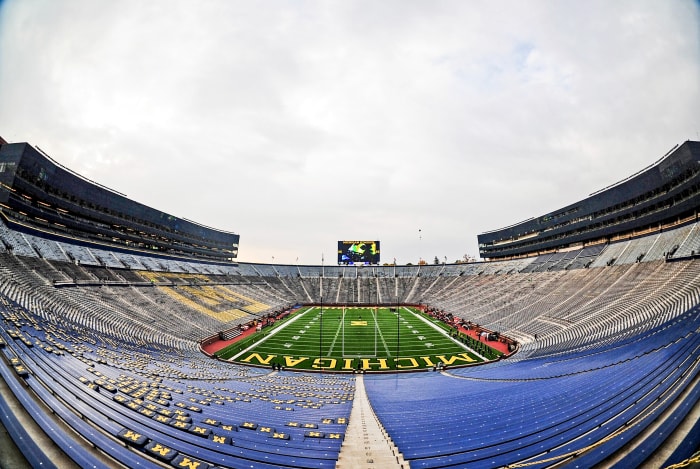
With no games, the normally-raucous Michigan Stadium is set to be quiet this fall.
Andrew Weber/USA Today Images
“There’s definitely more upside than downside for Trump,” Martin says. “Now, if football comes back and it becomes disastrous—kids get sick and games and seasons are canceled, or games turn into super-spreader events—that’s the downside. … But if he can get on the campaign trail in La Crosse, Wisconsin, and say, ‘Look, guys, I tried,’ that will probably be well received.”
Not to be outdone, Joe Biden’s campaign issued a statement Tuesday night to the Toledo Blade about Trump’s Big Ten gambit: “This weekend could have been Ohio State’s first football game, but Trump’s failure to contain COVID-19 has sidelined the Buckeyes and America. While the virus rages on, small businesses around [Ohio Stadium] and other stadiums around our state continue to pay the price. …“
So the sport has become weaponized politically and ideologically, with competing sets of facts and medical experts. Along the way through this divisive summer, it has exposed some other underlying conflicts in our society: American individualism (each school/conference doing what it wants) vs. uniting as an entity (all conferences on the same page); creating community (which football does splendidly) vs. the increased opportunity for disease to spread via that community; and the increasing sentiment that college football players are owed more vs. the dark football pathology of old (manly men aren’t afraid of some stupid virus, and players should be grateful to have a free college education).
On Sunday, The New York Times’s editorial board slammed the fact that college football will be played this fall: “Saturday afternoon college football is a way of life for millions of Americans. But the players … are not essential in the middle of a pandemic that has already taken nearly 200,000 lives in the United States. The health and future of college players deserve far more consideration than they’ve gotten thus far from their coaches, their fans and the presidents of their universities.” And dozens of players have indeed opted out. Yet in August, parents of Big Ten players held public protests demanding that those very college athletes be given the right to play.
“What I found the most interesting in just how quickly people would put a stake in the ground about what’s right and what’s wrong,” says former North Carolina State athletic director Debbie Yow. “How does anyone know? We’ve never been through this before.”
The path through it has been full of missteps, altered courses and doubling back. After months of college football officials vowing that they would “follow the science,” in the end the major conferences are largely following the winds of politics based on their geographic locations. A map of who is playing and not playing could well presage the electoral college breakdown come November. Stanford coach David Shaw, whose team will not play this fall, puts it this way: “One of the things I’ve heard the last few weeks: When you mix medicine and politics, you get politics.”
***
John Barnshaw is a vice president for research and data science at Ad Astra, a higher education software company. Along with a colleague from Davidson College, he worked on a project that tracked college reopening plans for every university in the U.S., turning it into a popular guide on the Chronicle of Higher Education website. In the course of his research on who was reopening and how, Barnshaw discovered something interesting.
“If your college or university has NCAA football, it is predictive of whether your institution will be in-person [for classes] or online,” Barnshaw says. The schools that play football—especially high-end football—are “significantly more likely” to have in-person classes than those that do not. That finding is irrespective of the COVID-19 cases rate in those states.
Barnshaw found two other major predictive factors: state politics and the academic selectivity of the schools. But, once again, football matters. And, Barnshaw says, it helps shape decision-making in terms of how higher education deals with its academic approach this fall.
“It’s surprising that sometimes [political] partisanship and football can drive educational decisions,” Barnshaw says, “even more than COVID cases per 100,000. Football is going to matter to those universities that play it.”
Even at several schools that shut down classes, football has continued. In the spring, athletic administrators nationwide said they could not envision being able to play football without students (and classes) on campus. As the summer went on and the virus numbers soared—and also as schools figured out how to cocoon athletic programs—those goalposts weren’t just moved. They were taken out of the ground and put in storage.
In the Southeastern Conference, Alabama has continued with a hybrid approach to classes—some online, some in person—despite 1,300 positive cases in a short span in late August. South Carolina has not altered its academic approach despite reporting more than 1,100 positive cases earlier this week. Same with Georgia, which reported more than 800 cases as of Wednesday. Yet SEC football presses forward toward an anticipated Sept. 26 kickoff.
Is this medical expedience and common sense, or fan passion and dollars and cents?
Author Taylor Branch, a caustic critic of the college sports machinery, offers this pithy summation: “Successful theft makes a powerful tradition. Those who make decisions keep the money, and the essential talent bears risk with no say.”
I started to ask Donna Lopiano, a sports management consultant and member of the Drake Group, a college athletic watchdog organization, why football is so important. She cut me off and asked in return: “You mean, why is money so important? It’s never been about football. It’s always been about money. Athletics is a peculiar economic force within higher education, and it’s only in America. There is every incentive for coaches and athletic directors to collude to use the funds of a nonprofit organization for private gain.”
Not surprisingly, members of the SEC dispute the notion that their decisions are predicated on making money. They point out that each school is going to lose tens of millions of dollars even while playing this fall.
“We’ve removed roughly 17% of the regular-season schedule,” SEC commissioner Greg Sankey says. “We’re starting three weeks later. We’ve shifted all the dates around. We’ve shifted attendance plans to where everyone is 30% and below … The money starts to go away, and we’re spending money on testing and environmental safety standards that we never had spent before.
“Societally, there’s a greater need than ever to provide an attachment to something normal, to provide some commonality and a sense of community. There’s a reason to play college football, and a reason it matters. If you’re a player, this provides the connection to their campus community, their locker room, their team, their family—they’re all connected to their lives. … I had an emotional feeling in March [when winter sports championships and entire spring sports seasons were canceled] that we had removed a fundamental aspect of young peoples’ lives.
“This is their time. They love the games. There’s hope associated with the games. Last year was Joe Burrow’s time. This year it will be someone else’s time. What if they don’t get that chance? That’s part of the responsibility I feel to provide the opportunity to play.”
Says Alabama coach Nick Saban: “Everybody acts like we want to play for the money. We want to play for the players. I want to play for the players.” And this from North Carolina coach Mack Brown: “These young people are dying to play. Our young people would be crushed if they were told they couldn’t play.”
Wanting to “do it for the players” can be a rationalization as much as a reason, though. Like parenting, effective coaching often involves telling young people what they don’t want to hear. “Every positive decision I’ve made has been what’s best for the student-athletes,” Shaw says. “Not what they want, but what’s best.”
***
Why does football matter so much? Ask that question of highly successful people within the sport, and it’s notable how many answers circle back to childhood.
Archie Manning grew up across the street from the high school in Drew, Miss., and when he walked home for lunch he would often see the star quarterback outside the school with his girlfriend. Young Archie took note of what the quarterback was wearing and tried to wear the same thing the next day. On Saturdays he was fixated by the exploits of Ole Miss stars Charlie Conerly and Glynn Griffing. He went on to a legendary career of his own in Oxford and then raised three boys who loved the game the way he did.
Mack Brown remembers he and his older brother, Watson, having matching miniature versions of the high school team’s letter jackets in Cookeville, Tenn. They were five or six years old, and their grandfather coached the team. Riding on the team bus to away games was a thrill. The boys couldn’t wait to be old enough to play.
“I’ve had seven or eight knee operations and two knee replacements,” Brown says. “After all that, people ask me if I would do it all over and play again, and I say, ‘Absolutely.’ ”
Steve Spurrier, the former Heisman winner and SEC coach, recalls a growth spurt before his senior season at Johnson City High School in Tennessee—a growth spurt that helped him take over the quarterback position at precisely the time the coach was putting in a more pass-friendly offense.
“I had a chance to throw the ball,” Spurrier says. “I threw for four touchdowns, and we beat Churchill, 28–21. We got behind 21–0, and the coach said, ‘You can throw every down.’ I got a lot of publicity for four passing touchdowns. Now it’s not a big deal, but it was that day.”
And even Nick Saban was willing to divert his legendary focus long enough to reminisce about what football meant in his hometown.
“I know that sports tied our town together when I was growing up in Monongah, W.Va.,” Saban says. “The last guy turned the lights out because everybody went to the game. Everybody went to the football game on Friday night. Everybody went to the basketball games. I mean, they closed the pool room. They closed [the place] where we used to play pinball and played cards all night. They closed all those places because everybody went to the game.
“So why is that so important to people? They love sports. People identify with competition. A lot of the principles and values that make you a good player in sports, whether it’s pride in performance, personal discipline, your ability to sustain effort and toughness and persevere, overcome adversity. But it’s been a part of our society since back in the Greek days. That’s why it’s important.”
That’s why it’s intrinsically important on the inside of the game. But what about the outside? From a fan’s perspective? Why is it so important to them? The answers are rooted in tribalism, and the self-esteem associated with membership in a tribe.
“Your team is your team,” says Shaw, who has a sociology degree from Stanford. “For a few hours I might look past race and socioeconomic differences and pull together with people who aren’t like me for our team. You can be walking down the street and see a stranger wearing the sweatshirt for your team, and you high-five him. For that brief moment, you’re brethren.”
Says Brown: “You’re part of something bigger than yourself. The fans can identify with a team. When we win as a team, the fan is very proud, and he feels better. When the team plays bad, they feel bad. Whether you went to that school or not, you’re proud of the team you choose. Sally [Brown’s wife] and I have talked often about it. ‘Why do people want autographs? Why do they wear jerseys?’ It’s identification with that team, that institution, that group.”
Not all tribalism is positive tribalism, however. Fans can be selective. When things go badly, the tribe will turn on its heroes. During Brown’s extremely successful tenure at Texas, which included winning the 2005 national championship, he noticed a dynamic with a friend of his: When the Longhorns won, the friend used the “we” pronoun. When they lost, the pronoun was “you."
“This is something built within the founding of our country: We find a way to deify and a way to vilify,” Shaw says. “When athletes are successful, we say, ‘They’re the greatest. Are they the best ever?’ And very quickly we can say of the same athlete, ‘They used to be good, and now they’re terrible.’ There’s an attachment to putting someone on a pedestal and also to knocking them down off that pedestal. Fans are able to deify and vilify with no emotional attachment. When you have a violent, emotional sport, with extreme highs and lows, you have America’s sport."
Leave it to Spurrier, who loved to needle the programs he defeated, to sum up the tribal self-esteem dynamic perfectly: “Whoever wins the game, the fans, as they’re leaving the ballpark, can leave saying, ‘I’m smarter than you guys, I’m tougher than you guys, and I know how to win better than you do.’ ”
***

There will be no games for David Shaw (right) and the Cardinal in fall 2020.
Stan Szeto/USA Today Images
David Shaw is 48 years old, and this will be his first fall without football.
He’s the son of a coach. Willie Shaw worked at the college level when David was born and then spent 16 seasons in the NFL. David played at Stanford and quickly went into coaching himself after graduation.
Does football matter deeply to him? Has it always mattered deeply to him? Oh, yeah.
So it’s different today, when the practice fields at Stanford are not crackling with the customary September urgency. There are no games. Hopefully in 2021, but there are no guarantees.
Shaw will turn on the TV this weekend, and the finality of the fall will hit him. Still, he is at peace with the situation. His colleagues in the Big Ten haven’t stopped scheming and screaming, but you’ll hear none of that emanating from the head coach of the Cardinal.
“I do believe we made the right decision,” Shaw says. “I’m going to have that pit in my stomach [watching football], because I love the sport. When the time is right and we can play in an environment that is safe for the student-athletes and for our staff, we’ll get our chance to go out and compete. And we’ll be ready.”
Read more of SI's Daily Covers stories here
More NCAA Coverage From SI.com Team Sites:
Trump’s Reelection Campaign Politicizes America's Football Addiction
Biggest Stories From Each SEC Program as Camp Heats Up
What Might Have Been for Penn State Football in 2020



